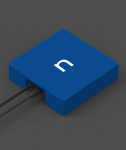 Flic smart buttons first appeared at CES 2015 and since then, they’ve made steady progress as a useful element of a smart home solution. CES 2018 saw the introduction of the Flic Hub which eliminated the need for a nearby smartphone to process activity.
Flic smart buttons first appeared at CES 2015 and since then, they’ve made steady progress as a useful element of a smart home solution. CES 2018 saw the introduction of the Flic Hub which eliminated the need for a nearby smartphone to process activity.
Flic buttons are little rubberised push switches that use Bluetooth to communicate with the complementary Flic smartphone app (or Flic Hub), which then initiates actions based on rules created in the app. There’s lots of flexibility built into the app so the Flic can turn on lights or make Skype calls – all kinds of things.
 Flic 2 is coming to Kickstarter on Tuesday and the Swedish team is promising a brand new open platform to encourage community development and integration with other smart home systems. The buttons themselves have been improved with a new design, improved range, better tactile response and a three-coloured LED for additional feedback.
Flic 2 is coming to Kickstarter on Tuesday and the Swedish team is promising a brand new open platform to encourage community development and integration with other smart home systems. The buttons themselves have been improved with a new design, improved range, better tactile response and a three-coloured LED for additional feedback.
The Flic buttons will support Bluetooth HID (Human Interface Device) meaning the Flics can emulate keyboards, mice, gamepads and other devices. Maybe you want a button to do a screen grab – that’s when you could use HID to “press” PrtScn.
 Although I don’t have a Flic Hub, I understand it has a IR port and can control TVs, set-top boxes and media players – anything that has an IR remote control. It would be handy to power everything down without having to find all the remote controls at the end of the day.
Although I don’t have a Flic Hub, I understand it has a IR port and can control TVs, set-top boxes and media players – anything that has an IR remote control. It would be handy to power everything down without having to find all the remote controls at the end of the day.
If you are interested in more details, you can sign up here (disclosure: this link will get me some Flic brownie points), or you can wait for Flic 2 to launch on Kickstarter at 1600 BST / 1100 EST on 21st May 2019. Looks like there’s some good value early bird specials.
In particular, I’m hoping there will be good integration with Samsung’s SmartThings. Fingers crossed.















